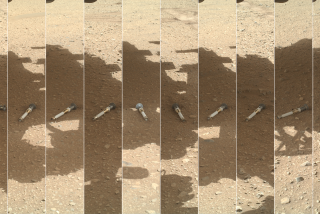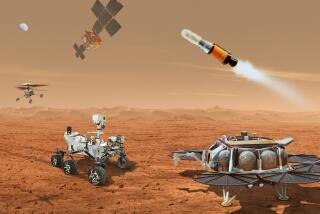NASA’s 2nd Rover Lands on Mars
Blazing a fiery trail through the Martian atmosphere, NASA’s Opportunity rover landed safely at 9:05 p.m. Saturday, rolling to a stop in Meridiani Planum a few minutes later to score a clean sweep for the agency’s twin missions to the Red Planet.
“We’re on Mars, everybody,” entry, descent and landing manager Rob Manning announced to a burst of cheering and applause in the mission control room at Pasadena’s Jet Propulsion Laboratory.
Manning broke into unabashed tears as the laboratory accomplished a historic first, landing two rovers on another world only three weeks apart.
Gov. Arnold Schwarzenegger and former Vice President Al Gore, on hand for the occasion, immediately entered the control room to congratulate the controllers. The governor was presented a broom by landing specialist Wayne Lee to mark the clean sweep.
“Second success is even sweeter than the first one,” JPL director Charles Elachi said. “It’s hard to get lucky twice in three weeks.”
Like the earlier landing of Spirit on Jan. 3, the entire “six minutes from hell” proceeded flawlessly, with Opportunity decelerating from 12,000 mph to zero before the air-bag-equipped lander was released and allowed to bounce to a soft landing.
Word of the safe landing was received by Deep Space Network antennas in California and Australia, which relayed data throughout the descent. “It’s really phenomenal to be able to detect these signals that are so weak and so far away,” Manning said.
At 9:20 p.m., the lander reported that it was healthy and that it had ended up on its side, a configuration that will require it to spend a little extra time righting itself before opening the lander shell and deploying its solar panels.
Preliminary data indicated that the craft had landed about 15 miles downrange from its target site because the Martian atmosphere was slightly thinner than predicted, Manning said.
The landing capped a day of intense activity in Pasadena as JPL engineers had earlier reported tracing a malfunction that has idled the Spirit rover to a computer memory problem.
Project manager Pete Theisinger said they believe they can restore the craft to nearly full operation in a matter of weeks.
“We’re upgrading its condition from critical to serious,” Theisinger said.
Ed Weiler, NASA’s associate director for space sciences, said: “We resurrected one rover today and saw the birth of another.”
Controllers were able to reestablish contact with Spirit overnight Friday, and received data indicating that the problem lies in the craft’s flash memory, which functions much like the memory stick in a digital camera.
Theisinger said he was confident that the problem could be either repaired or circumvented.
“It will take us a couple of weeks to get back close to routine operations,” he said. “And we are probably three weeks from driving the rover.”
The recent problems with Spirit began Wednesday morning, when the craft abruptly stopped transmitting data to Earth.
The team subsequently found that Spirit’s on-board computer was rebooting itself about once every hour and that the craft was not going to sleep during the long, cold Martian night to conserve its batteries.
The team had some very slow communications with the craft Thursday, then got an unexpected burst of data during the Martian night via the Mars Odyssey orbiter. Those data gave them a hint that the flash memory was involved.
When controllers made contact with the craft again, they ordered it to go into a “cripple” mode, which bypassed the flash memory, and then to reboot.
After it rebooted, they had a one-hour, low-speed communication session with the craft with no apparent problems. Significantly, reboots did not occur after that, Theisinger said.
The team then ordered the craft to go to sleep, so that its batteries could be recharged.
The rovers have three types of memory: RAM (random access memory), flash and EEPROM (electrically erasable programmable read-only memory).
RAM is similar to that in a home computer, and is used for temporary storage of instructions and data. Any information in the RAM is lost when the system is shut down.
Flash memory provides longer-term storage and is used for scheduling the rover’s daily activities and storing scientific information until it is transmitted to Earth. Information stays in the flash memory until it is deliberately erased.
EEPROM is similar to flash memory, but its information is harder to erase and it serves as a more permanent form of memory.
The rover’s core programming is contained in EEPROM, and it does not seem to be affected by the current problem.
After Spirit’s batteries have been recharged, the team will wake up the craft and place it in cripple mode again -- a task that must be carried out each day.
They then will set up a high-speed communications link, probably through the Mars Odyssey orbiter, to download the contents of the flash memory so they can figure out what happened.
The team has not yet discounted the possibility that a hardware problem might be the root cause of Spirit’s ailment, Theisinger said.
The whole episode began while the craft was adjusting the mirror on its thermal emission spectrometer. “We still do not know why that happened,” he said. Spirit can function without flash memory if necessary, Theisinger said.
The most important effect would be that scientific data collected during a Martian day would have to be beamed back to Earth before the craft entered sleep mode, or else the information would be lost. That might reduce the amount of data collected somewhat, but would not make the mission a failure.
Spirit is halfway around Mars from Opportunity’s landing site in Meridiani Planum. Geologists targeted that site because it has a feature seen nowhere else on Mars, or on Earth: an Oklahoma-sized deposit of an iron-containing mineral called hematite.
A shiny, crystalline ore, hematite is most commonly produced in water, and scientists think the massive deposit in Meridiani was laid down by an ancient lake. That suggests there once were large quantities of water on the surface of Mars and, where there was water, there very well could have been life.
“The surface of Mars is desolate, cold, dry and barren -- not an enticing environment for life,” said geologist Steve Squyres of Cornell University, principal investigator on the rover missions. But places such as Meridiani offer “hints that it could have been a very different sort of place in the past.”
The mission of NASA’s twin rovers, as well as of Britain’s failed Beagle 2 lander, is to look for evidence of “whether there was water and whether it was favorable for life,” said project scientist Joy Crisp.
Meridiani Planum is within a large region that has been known as Meridiani since the earliest days of telescopic study of Mars because it lies near the planet’s arbitrarily designated prime meridian, or line of zero longitude.
“Planum” means plain, and the name fits. Meridiani Planum is one of the smoothest, flattest places on Mars.
The hematite makes it one of the most interesting sites. The gray mineral was discovered by an instrument called a thermal emission spectrometer on the Mars Global Surveyor orbiter.
Hematite covers an estimated 15% to 20% of the surface in the vicinity of the proposed landing site. In photographs, it appears as a dark layer atop a brighter layer of Martian soil that is exposed in many areas of the region.
“The hematite outcrop is right on the equator ... and it just kind of called to us to go to it,” said geologist Ray Arvidson of Washington University, the deputy principal investigator.
On Earth, hematite is most often formed in association with water, either in iron-rich lakes or in hot water percolating underground. If Opportunity finds sedimentary rocks of the type found in lake beds associated with the hematite, that would be strong evidence that a lake once existed on the site.
Alternatively, the presence of certain characteristic minerals in conjunction with the hematite would indicate that it had been formed by hot water circulating in the soil. The instruments on Opportunity’s flexible arm will look for the presence of those minerals.
A third possibility -- and the least desirable one, from the scientists’ viewpoint -- is that the hematite was produced by the direct oxidation of volcanic rock without the presence of water. If Opportunity finds only volcanic rocks at Meridiani, that would support this possibility.
More to Read
Sign up for Essential California
The most important California stories and recommendations in your inbox every morning.
You may occasionally receive promotional content from the Los Angeles Times.










